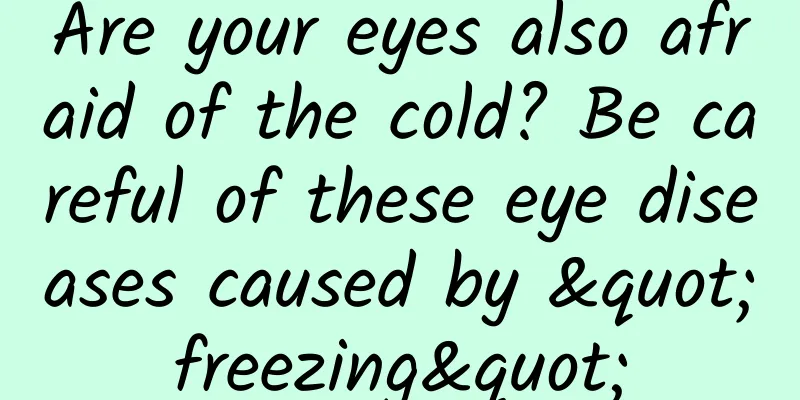Are your eyes also afraid of the cold? Be careful of these eye diseases caused by "freezing"

|
After the winter solstice, water turns to ice Workers shivering in the cold winter Always hold your heating equipment close We are exposed to the cold wind Hats and scarves helped a lot But the eyes still have no suitable protective layer But! It is very afraid of cold! And it’s easy to get sick when it’s cold! Attention! Attention!! The following eye diseases are common in winter and can cause blindness in severe cases Be sure to take precautions! 1. Tear duct disease: tears in the wind Involuntarily shed tears without external stimulation. In the cold wind, tears always flow, and tears flow when the wind blows. In fact, crying for no reason may be a manifestation of tear duct disease. Tear duct disease mainly refers to the blockage of the tear duct, which is a common type of ophthalmological disease. Tears are one of the main symptoms of tear duct disease. When the tear duct is blocked, tears cannot be discharged and are "blocked" in the lacrimal sac for a long time. The bacteria produced constantly stimulate the wall of the lacrimal sac, thereby producing mucous or purulent secretions and forming chronic dacryocystitis. Chronic dacryocystitis has little effect on vision in the early stages, but if left untreated, many chronic dacryocystitis can easily develop into acute dacryocystitis, orbital cellulitis, etc. Director Xie Yangyang of the tear duct/eye and nose related specialist reminds: If your eyes repeatedly shed tears or even pus, you must go to the hospital for medical examination as soon as possible to avoid further damage to your eye health. 2. Dry Eyes Dry and cold winter is the peak season for dry eye syndrome, which is ocular surface damage and discomfort symptoms caused by imbalance in tear film homeostasis. It is often manifested as dry eyes, foreign body sensation, burning sensation, red and itchy eyes, blurred vision, pain, photophobia and tearing. Because the climate is relatively dry in winter and tears evaporate more, many people reduce outdoor activities, use air conditioners and heaters for long periods of time to keep warm, often stay at home to watch TV, surf the Internet, etc., and excessive use of the eyes at close range can easily lead to symptoms such as dry and astringent eyes. Director Long Fengjiao of the Department of Ocular Surface and Corneal Diseases reminds: It is recommended to reduce excessive eye use in daily life, take a rest when you feel tired or uncomfortable, do more blinking exercises, look into the distance or close your eyes to rest. Pay attention to eye cleanliness, wear less eye makeup as much as possible, and take care to remove makeup thoroughly; wear a wet chamber lens to reduce tear evaporation when going out or using electronic products. Dry eye disease is very harmful if it is not treated for a long time, which will damage the cornea and cause severe dry eye disease. 3. Glaucoma The temperature is low in winter, and the cold stimulation can excite the sympathetic nerves. Some people have abnormal eyeball structures such as shallow anterior chamber and narrow chamber angle, and their intraocular pressure will rise sharply in a short period of time, which is very likely to induce glaucoma. Patients will experience eye pain, sharp decrease in vision, headache, eyeball hardness, pupil dilation, conjunctival congestion, accompanied by nausea, vomiting and other symptoms. Most chronic glaucoma may not have any typical symptoms in the early stages. By the time it is discovered, the lesions have already developed to the middle and late stages, with obvious and irreversible visual function damage such as decreased vision, narrowed visual field, and optic nerve atrophy. Director Zhang Ying of the glaucoma specialist reminds: People who are prone to glaucoma, such as those with a family history of glaucoma, middle-aged and elderly people, those who take oral hormones for a long time, and those with high myopia, especially those over 65 years old, should go to a regular hospital regularly to rule out the possibility of glaucoma. 4. Eye stroke The medical name for "eye stroke" is retinal artery occlusion, which is rapid and has a high blindness rate. In winter, the blood vessels in the eyes contract when exposed to cold, and blood flow slows down, which can easily cause retinal artery occlusion, leading to "eye stroke". Middle-aged and elderly people with underlying diseases are at high risk of "eye stroke", but young people with underlying diseases and irregular lifestyles are also likely to suffer from it. The disease is fierce, and the golden emergency time is within 60-90 minutes, and rescue should be carried out within 4 hours as much as possible. Director Li Xiangyun of the Department of Ophthalmology reminds: To prevent eye stroke, you need to develop good living habits, avoid excessive fatigue and tension, relax, reduce stress, and ensure adequate sleep. For the elderly, timely diagnosis and treatment of various geriatric diseases and cardiovascular diseases are required. High-risk groups should have regular fundus examinations to detect early lesions in a timely manner. 5. How to protect your eyes in winter? 1. Healthy food supplement Some nutrients needed by the eyes cannot be synthesized by the eyes themselves and can only be taken in from the outside. Therefore, you can eat some foods that are good for the eyes, such as reasonable vitamin supplements (lutein, carotenoids, vitamin A, etc.). 2. Artificial tears for dry eyes For patients with tear deficiency dry eyes, you can use some artificial tears to relieve symptoms. It is recommended not to use artificial tears containing preservatives. If the discomfort is severe, please go to an ophthalmologist in time. 3. Hot compress to protect your eyes Hot compresses on the eyes can promote blood circulation in the eyes and relieve visual fatigue to a certain extent. It can also promote the secretion of tears and prevent the eyes from being too dry. 4. Be careful when wearing contact lenses Tears evaporate faster in winter, and eyes are prone to dryness and even dry eye symptoms. When wearing contact lenses in foggy days, tiny pollutants in the air will adhere to the lenses of the contact lenses, irritating the eyes and causing eye allergies. 5. Wear sunglasses in strong light The ultraviolet rays in outdoor sunlight are also relatively strong in winter. When going out to play in the sun, remember to wear UV-proof sunglasses. 6. Do some outdoor exercise In winter, you should still do some outdoor exercise and avoid staying indoors for a long time. Look into the distance and breathe fresh air. While improving your physical fitness, it can also help your eyes rest and avoid long-term close-up use of your eyes. |
<<: The probe farthest from human beings is sending a string of repeated garbled codes to the earth
>>: The movable type printing in history textbooks is still in use in this small village!
Recommend
Uncle Operations: I wish all CPs and channel partners in the mobile circle a happy Mid-Autumn Festival!
During this typhoon, I body exist Xiamen, a beaut...
WP8.1 preview version upgrade
Microsoft has officially started pushing WP8.1 upd...
From C pseudocode to assembly, hands-on implementation of objc_msgSend
The objc_msgSend function underpins everything we...
Things to note when applying for 400 telephone numbers
Since its emergence, 400 telephones have graduall...
Weekly Science Talk|Little Lactobacillus can also achieve great things
Lactic acid bacteria are a type of bacteria that ...
Muscovite: thin and hazy thousand-layer paper, mica screen with deep candlelight
This issue introduces a white mica specimen from ...
Saury self-media + Douyin operation course, teach you step by step how to make money by playing short videos
Saury self-media + Douyin operation course, teach...
One article to understand Toutiao advertising placement
" Toutiao " is a personalized recommend...
Marketing promotion program skills and planning methodology
I have heard many of my friends and colleagues ta...
A complete guide to advertising on TikTok!
You may be running campaigns on more established ...
Xiaohongshu operation guide teaches you to avoid 90% of the pitfalls!
Faced with Xiaohongshu’s precise user group of 20...
Eliminate the "ecological killer", this time it is the MeeMee team that made a great contribution!
Recently, Canada goldenrod It has appeared again ...
How to advertise on Weibo? What are the methods of Weibo promotion?
Weibo is one of the most popular and active socia...
WeChat responds to reading user photo albums: This function will no longer be used
Earlier today, some netizens revealed that WeChat...









